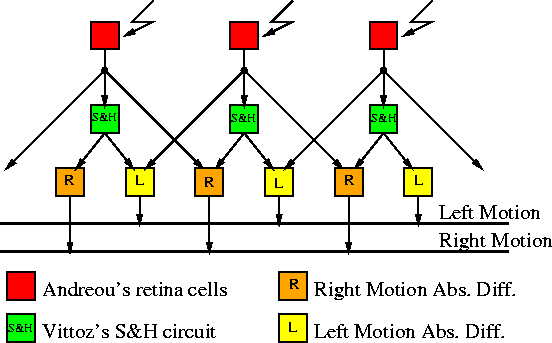Meitzler et al. [Meitzler et al. 93] describe a 1D motion detection chip similar to Reichardt correlation-based motion detectors. Instead of using a delay element as in Reichardt model, Meitzler has used sample and hold to delay the signal. The reason in using sample and hold has been stated to be the need to integrate the output of the motion detector, which would have otherwise saturated due to offset voltage in the delay stage. The architecture of the sample and hold motion detector is shown in Figure 3.10. The front-end of the chip uses Andreou's retina cells, which is described in Section 2.6 [Andreou and Boahen 94b]. The sample and hold circuit is based on Vittoz et al.'s circuit described in [Vittoz et al. 91]. This S&H circuit has a relatively long (in the order a few minutes) retention time. It should also be noted that the multiplication required in Reichardt's model has been replaced by an absolute value of difference function.
The chip has been fabricated in a 2 ![]() m CMOS process in a ``Tiny''
chip (2.2mm
m CMOS process in a ``Tiny''
chip (2.2mm ![]() 2.2mm). It contains 22 cells, each occupying an
area of 365
2.2mm). It contains 22 cells, each occupying an
area of 365 ![]() 77
77 ![]() .
.

Figure: Meitzler et al.'s sample and hold motion detector.